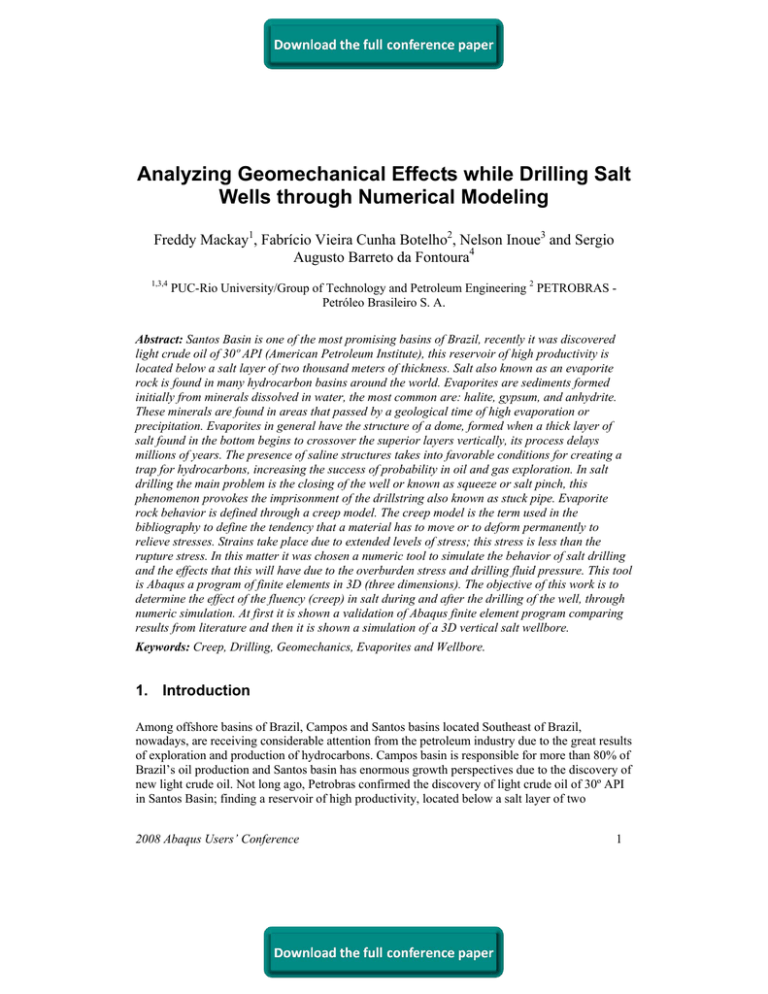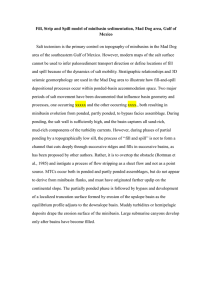Analyzing Geomechanical Effects while Drilling Salt Wells through Numerical Modeling Freddy Mackay
advertisement

Analyzing Geomechanical Effects while Drilling Salt Wells through Numerical Modeling Freddy Mackay1, Fabrício Vieira Cunha Botelho2, Nelson Inoue3 and Sergio Augusto Barreto da Fontoura4 1,3,4 PUC-Rio University/Group of Technology and Petroleum Engineering 2 PETROBRAS Petróleo Brasileiro S. A. Abstract: Santos Basin is one of the most promising basins of Brazil, recently it was discovered light crude oil of 30º API (American Petroleum Institute), this reservoir of high productivity is located below a salt layer of two thousand meters of thickness. Salt also known as an evaporite rock is found in many hydrocarbon basins around the world. Evaporites are sediments formed initially from minerals dissolved in water, the most common are: halite, gypsum, and anhydrite. These minerals are found in areas that passed by a geological time of high evaporation or precipitation. Evaporites in general have the structure of a dome, formed when a thick layer of salt found in the bottom begins to crossover the superior layers vertically, its process delays millions of years. The presence of saline structures takes into favorable conditions for creating a trap for hydrocarbons, increasing the success of probability in oil and gas exploration. In salt drilling the main problem is the closing of the well or known as squeeze or salt pinch, this phenomenon provokes the imprisonment of the drillstring also known as stuck pipe. Evaporite rock behavior is defined through a creep model. The creep model is the term used in the bibliography to define the tendency that a material has to move or to deform permanently to relieve stresses. Strains take place due to extended levels of stress; this stress is less than the rupture stress. In this matter it was chosen a numeric tool to simulate the behavior of salt drilling and the effects that this will have due to the overburden stress and drilling fluid pressure. This tool is Abaqus a program of finite elements in 3D (three dimensions). The objective of this work is to determine the effect of the fluency (creep) in salt during and after the drilling of the well, through numeric simulation. At first it is shown a validation of Abaqus finite element program comparing results from literature and then it is shown a simulation of a 3D vertical salt wellbore. Keywords: Creep, Drilling, Geomechanics, Evaporites and Wellbore. 1. Introduction Among offshore basins of Brazil, Campos and Santos basins located Southeast of Brazil, nowadays, are receiving considerable attention from the petroleum industry due to the great results of exploration and production of hydrocarbons. Campos basin is responsible for more than 80% of Brazil’s oil production and Santos basin has enormous growth perspectives due to the discovery of new light crude oil. Not long ago, Petrobras confirmed the discovery of light crude oil of 30º API in Santos Basin; finding a reservoir of high productivity, located below a salt layer of two 2008 Abaqus Users’ Conference 1



